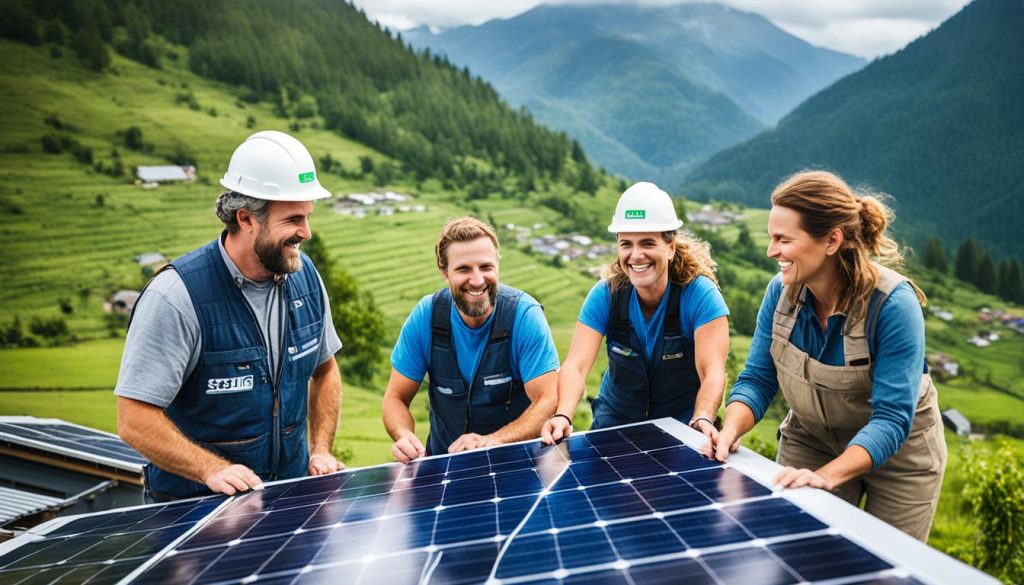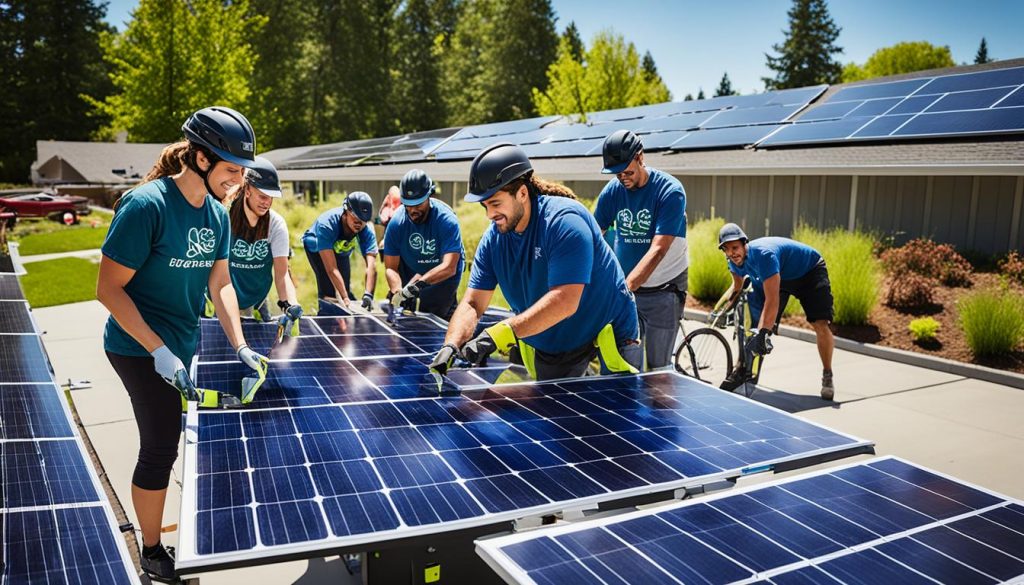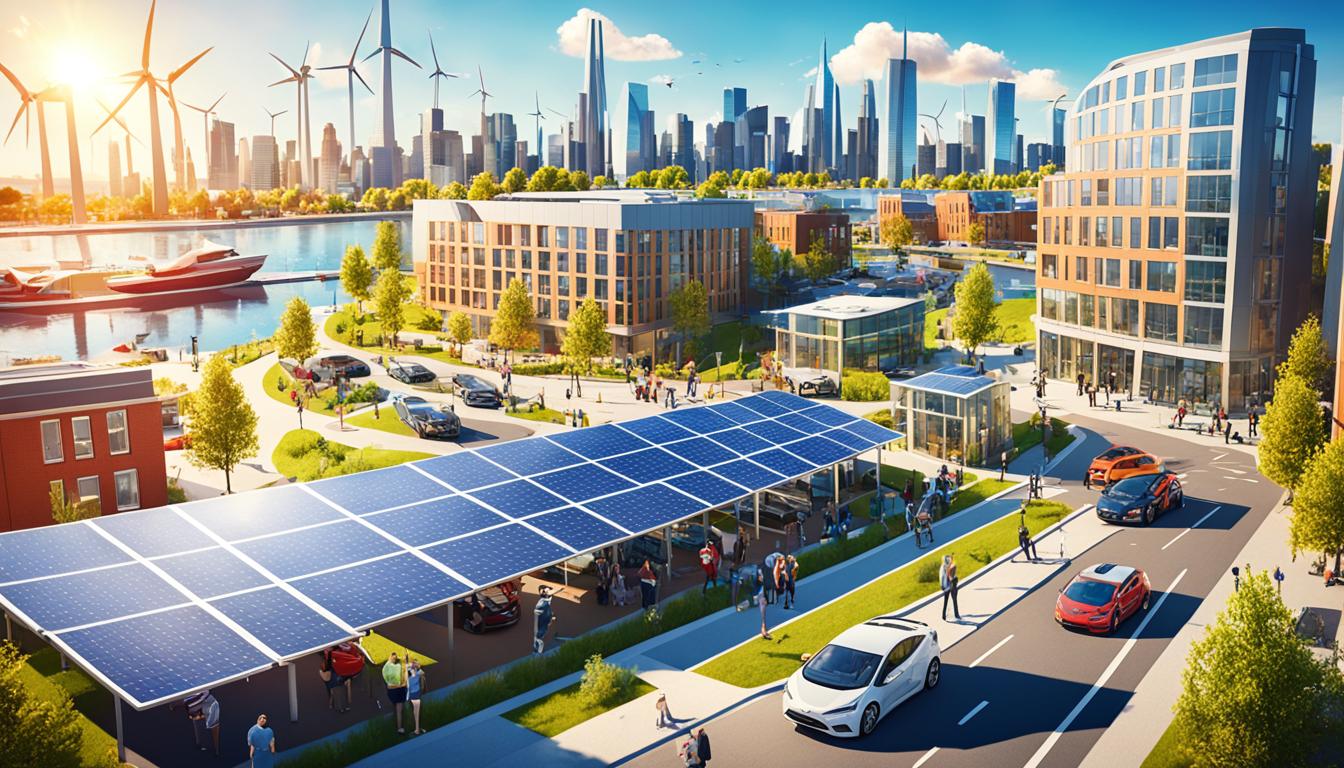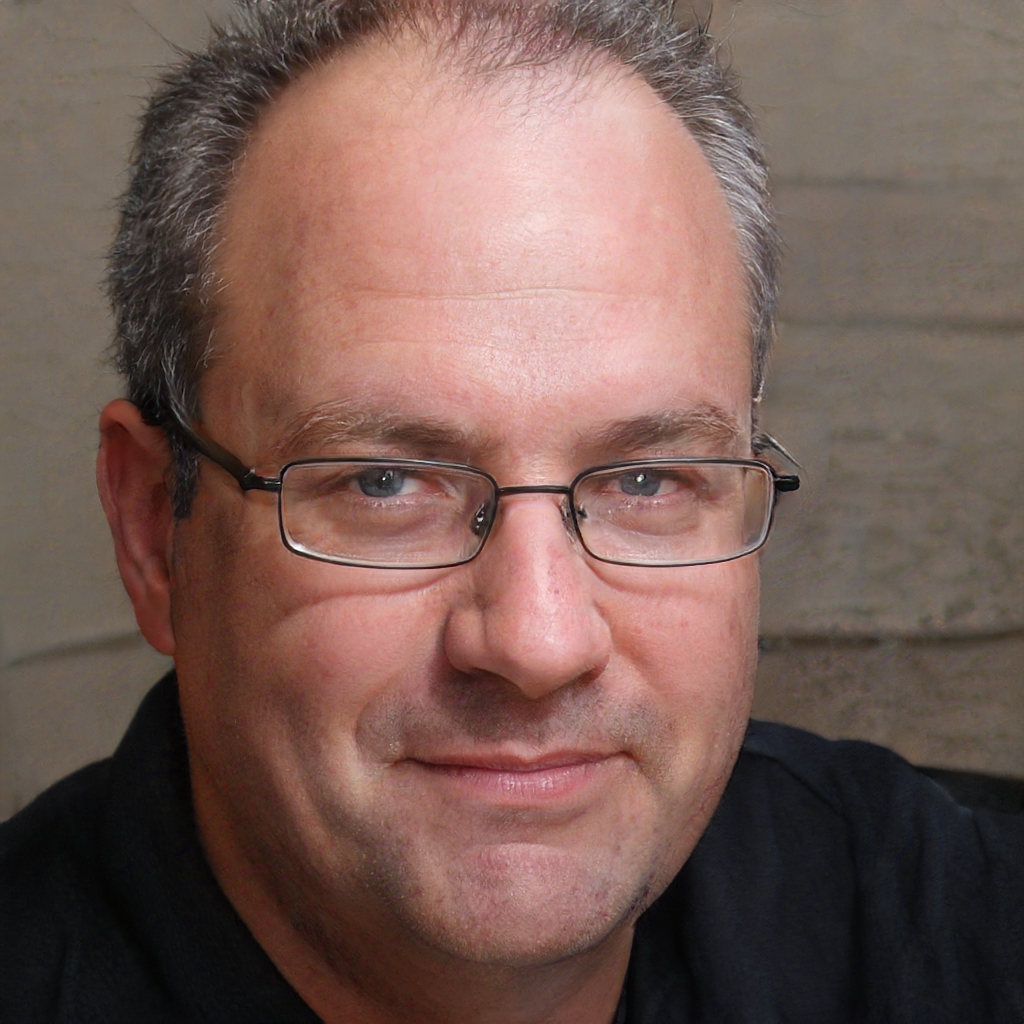As a global citizen, I see the need to switch to renewable energy sources. This means using solar, wind, and hydropower. We should do this to protect our planet’s future1. Let’s support clean energy initiatives and green technology. This will help us create a sustainable future and use less harmful fossil fuels.
Now is the best time to make a change. Sustainable power generation is getting cheaper and more available1. Let’s make wise choices and back new solutions. Together, we can make our world cleaner and greener for all, now and in the future.
Renewable Energy: The Key to a Sustainable Future
The world faces a big problem with climate change. Using renewable energy sources is a key answer for our future. These eco-friendly energy solutions help cut down on our carbon footprint. They also keep our energy supply safe for the long run and help our economy grow.
Abundant and Renewable Sources of Energy
Solar, wind, and hydropower are from natural processes that never run out. They give us endless clean energy.
- Unlike fossil fuel alternatives, renewables make almost no greenhouse gases2.
- The sun, wind, and water never stop, so we’ll always have energy2.
- Getting energy from many places cuts waste and makes energy use better2.
Reducing Greenhouse Gas Emissions
Using renewable energy is a main way to fight climate change. It cuts down on greenhouse gases a lot. This way, we make power with no harm to the planet from burning fossil fuels2. This helps our air be cleaner, which is good for people and nature.
Transition from Fossil Fuels to Renewables
Now, many countries know we must act fast because of climate change. They are working hard to use more renewable energy.
The International Energy Agency (IEA) sees renewables as 90% of new electricity sources by 20273.
India, Saudi Arabia, and other places are making big plans for renewable energy. They want to use more local energy and not rely on imports23.
Thanks to new technology, going for renewable energy is cheaper and better. By investing and making the right policies, we can easily switch to a more green future23.
The Global Village Energy Partnership (GVEP)

The GVEP helps make sure everyone gets to use new, clean energy. It works to make countries and cities better by getting them to promise to lower the energy problems4.
Increasing Access to Modern Energy Services
More than 180 groups, like governments, have joined the GVEP to make changes4. They share news every two weeks with over 3,000 people about how to get energy better4. The GVEP has also got promises of $2.9-3.3 million to help in three years. This shows many want to help4.
The GVEP holds workshops where people from different areas learn from each other. For instance, they had one in Sri Lanka with 50 people from around South Asia4. These workshops help in getting everyone to work together against energy poverty.
Empowering Rural and Urban Communities
GVEP tries to help in both the countryside and the cities because problems can be different. In Africa, they’ve had meetings in places like Ethiopia, Senegal, and Cameroon. These meetings help plan big projects to fight energy poverty4. Also, they support the “Moving Energy Initiative” to give clean energy to over 60 million people who had to leave their homes5.
“GVEP International’s programs have benefited over twelve million people, showcasing the immense potential for sustainable energy solutions to transform lives.”5
GVEP works in more than 120 places and has a network of over 2,000 groups. They support new ideas, like the IDEAS contest, which helped 26 projects in Latin America and the Caribbean. This is how they fight energy poverty6.
Clean energy initiatives: Efficient Energy for Sustainable Development
Clean energy is crucial for a greener future. It involves smart energy use to reduce waste and pollution. By using modern methods and products, we aim to improve how we make and use energy7.
Improving Energy Efficiency and Productivity
Clean energy efforts target better use of energy and more productivity. In New York, the Climate Act wants to cut greenhouse gases. The goal is to cut them 40% by 2030 and at least 85% by 2050, from 1990 levels7.
This is being done by adding more renewable energy. For example, New York plans for 6 GW of solar power by 2025. Plus, it aims to have 3 GW of energy stored by 20307.
Another goal is to have 9,000 megawatts of offshore wind by 2035 in New York. The NY-Sun Program is helping make solar energy easy to get, with a goal of 6 GW by 20257.
Reducing Energy Waste and Pollution
To cut waste and pollution, clean energy pushes efficient tech. In New York, by 2030, 6 GW of energy storage is planned. This includes helping people get efficient storage systems through incentives7.
The Clean Heat Program supports using heat pumps. This lowers fossil fuel use for heating, cut emissions, and helps with air and water heating. The aim is to stop selling new gas vehicles by 2035, and new gas trucks and buses by 2045. This is a big step for the environment7.
Facilitating Financing for Clean Energy Projects
Finding money for clean energy projects can be hard. That’s where the NY Green Bank helps. It offers financial tools to boost clean energy projects. This makes it easier for people and companies to go green7.
And then there’s the Clean Energy Initiative (CEI). It gives big money for making affordable houses energy efficient8. With CEI, it’s possible to build houses that use very little energy, promoting a greener world8.
“The transition to clean energy is not only an environmental imperative but also an economic opportunity, fostering innovation, creating jobs, and driving sustainable growth.” – Anonymous
Clean energy initiatives are changing how we live for the better. They offer funds and take down money barriers. This helps more people and areas join in making the world cleaner and greener8.
| Clean Energy Initiative | Funding Provision |
|---|---|
| Substantial Rehabilitation | Up to $30,000 per unit, maximum $9 million |
| Moderate Rehabilitation Level 1 & 2 | Up to $21,500 per unit, maximum $3.225 million |
This table shows how much money is available for making homes better for the environment8. Different projects can get different amounts. But all are helping to save energy and build a sustainable future8.
As we go on, clean energy efforts will be more and more important. They will help everyone get energy that’s affordable, reliable, and good for the planet. Since 2015, the number of people with electricity has gone up to 91%. But, about 660 million still might not have electricity by 2030 if things stay the same9.
We all can help speed up the move to a cleaner future by supporting clean energy. This way, we can have more efficient energy, protect the environment, and grow our economy9.
The U.S. Clean Energy Initiative
The U.S. Clean Energy Initiative helps people around the world get clean energy. It focuses on clean energy initiatives and saving the environment. Programs like the Global Village Energy Partnership work to make energy more available. This helps improve the way we use energy and cuts down on deaths from pollution.
Promoting Clean Transportation Fuels
This program also gets behind clean vehicle fuels. Thanks to the Inflation Reduction Act, buying an electric car is cheaper. Families can save a lot on gas over the life of their car10. They can even get up to $7,500 in tax breaks for getting a new electric car10.
The Department of Energy is spending over $24 billion to set up more places to charge electric cars, too11. This push for electric vehicles is a big part of making our roads cleaner.
It’s also working on making electricity cleaner. Sites like the Idaho National Laboratory are being set up for giant solar projects. These could give power to thousands of homes12.
All this goes with President Biden’s plan. The plan wants all government buildings to use completely clean electricity by 203012.
Healthier Indoor Cooking and Heating Practices
The push is on for cooking and heating at home to be healthier. Putting a heat pump in your home can earn you up to $2,000 in tax breaks. It uses less energy and cuts down on pollution10.
There are also tax breaks for installing solar panels. They help lower energy bills and reduce your carbon footprint10.
The U.S. Clean Energy Initiative wants to make clean energy more common in America. It uses money incentives and supports projects to help the environment. These steps are moving us towards a more sustainable and efficient energy future101211.
The Economic Benefits of Clean Energy Initiatives
Our move towards a sustainable future is boosting our economy. Investments in green technology are creating jobs and leading to growth. This change to renewable energy is smart for our planet and our wallets.
Cost Competitiveness of Renewable Energy
Clean energy is getting cheaper, making it more appealing. For instance, in many places in the U.S13., solar power costs less than other energy sources. And wind energy is also getting more competitive. It’s likely that clean energy will become even more affordable everywhere13.
“The economics of alternative energy have entered a virtuous cycle of demand and cost reduction. The more proactive policies are in place, the greater the investment – and the lower the costs for consumers.” – Michael Liebreich, Bloomberg New Energy Finance
Job Creation and Economic Growth
Clean energy doesn’t just help our planet. It also boosts our economy and creates jobs. By 2030, the switch to renewable energy could add 9 million new jobs14. Every dollar spent in this area creates three times more jobs than it would in fossil fuel sectors14. In 2019, renewable energy projects on public lands contributed over $660 million in incomes to governments14. The construction of these projects has also added more than $13 billion to our economy since 199614.
Reduced Health and Environmental Costs
Clean energy could save $4.2 trillion every year by 203013. It helps limit pollution and lessen the effects of climate change. Additionally, it can lower the number of people with heart and lung diseases, and allergies13. This would better everyone’s health and cut healthcare costs.
- Reliable and sustainable renewable energy sources improve energy security and resilience, driving inclusive economic growth.
- Clean energy investments create new industries, stimulate innovation, and open doors to export opportunities.
- The transition to clean energy is an opportunity to revitalize local economies and empower communities.
Now is the perfect time to support clean energy. By investing in green technology, we can create a wealthier, job-filled, and eco-friendly future.
Challenges and Opportunities in Clean Energy Transition

As the world moves towards clean energy, we meet many challenges and chances. These need us to work together and think of new ways. We must beat obstacles in rules and policies, support partnerships, and make sure everyone gets a fair deal in the switch to clean energy.
Overcoming Policy and Regulatory Barriers
Understanding the rules and policies is hard in the clean energy shift. Old ways and different rules slow down green tech growth15. Yet, some places have made smart policies, making the cost of wind and solar power drop a lot, to just $20/MWh to $50/MWh15.
To speed up, we need to make rules simpler, reward investment in green jobs, and update our power networks. With rules that help, we can use the power of green tech fully. This means more wind and sun power for us all.
- By the end of 2032, the microgrid market could grow by $168.64 Billion. It might get with a CAGR of 18.7% from 2023 to 203216.
- Wind energy costs could go down by up to 35% by 20351615.
Fostering Public-Private Partnerships
To go green, we need to work together. Governments, companies, and groups must join forces. By teaming up, we can use our skills and tools better. This speeds up how fast we can switch to clean energy.
“Collaboration between the public and private sectors is essential to driving innovation, reducing costs, and scaling up clean energy technologies.” – World Economic Forum
Working together lets us do more with our money and know-how. We can make plans that fit each place’s needs and help all people.
Ensuring a Just and Equitable Transition
The change to clean energy must be fair, so everyone benefits. This means looking out for those hit hardest, like workers in old energy jobs or those in need15. We should help them find new jobs, and make sure they have a say in how things change.
Doing this means we all win. There will be more jobs, and we’ll live in a greener world that’s fair to everyone.
Powering Sustainable Development from Village to Metropolis
In our journey towards a greener future, getting affordable and clean energy is key. It’s crucial for the development of both small and big communities17. The U.S. took a big step by starting the “Clean Energy Initiative.” They pledged $42 million to help get more funds, up to $400 million, from other partners18. This effort is managed by the Global Village Energy Partnership (GVEP). It aims to give millions in the developing world access to up-to-date energy services. This happens through teamwork between the government and businesses.
These efforts include many countries and companies. Countries like Belize, Chile, and others work with companies such as American Electric Power and Chevron17. Organizations like the National Resources Defense Council also play a big part in moving this project ahead18. GVEP organizes various activities like workshops in Africa and Sri Lanka. They aim to share the best ways to improve energy access without harming the environment.
These activities help communities by not just giving clean energy but also by reducing poverty. They support education and health, and they make water access safer. Plus, they aim to lessen the over 3 million yearly deaths related to bad air and energy use17. If everyone works together, from the government to businesses and organizations, we can drive sustainable growth. This effort will help bring new technologies. It will make our world a fairer, cleaner place for everyone.
Source Links
- Renewable energy – powering a safer future | United Nations
- Renewable Energy: The Key to a Sustainable Future
- Investing In Renewable Energy For A Sustainable Future
- The Global Village Energy Partnership: U.S. Contribution
- Layout 1
- Clean Energy Initiatives
- Clean Energy Initiative
- Energy – United Nations Sustainable Development
- Investing in America – CleanEnergy.gov | The White House
- FACT SHEET: Biden-Harris Administration Launches Historic $20 Billion Competition to Catalyze Investment in Clean Energy Projects and Tackle the Climate Crisis | The White House
- DOE Announces First Projects Under New Cleanup to Clean Energy Initiative
- Health and Safety Benefits of Clean Energy
- Key Economic Benefits of Renewable Energy on Public Lands
- Challenges and opportunities beyond 2021 – Renewable energy market update – Analysis – IEA
- Harnessing Innovation for a Sustainable Future
- Powering Sustainable Development from Village to Metropolis
- U.S. Gives to Program for Developing Country Energy


